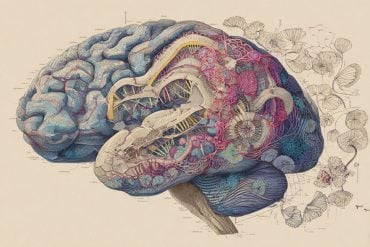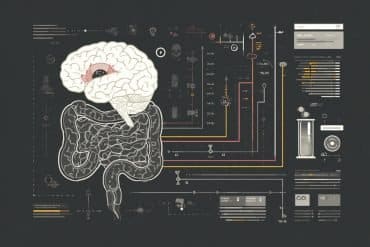Summary: ARHGAP11B, a gene unique to humans and active in the cerebral cortex, causes enlargement of the ferret neocortex when introduced during development.
Source: Max Planck Institute.
The human brain owes its characteristic wrinkled appearance to its outer layer, the cerebral cortex. During human evolution, the neocortex, the evolutionarily youngest part of the cerebral cortex, expanded dramatically and had to fold into wrinkles to fit inside the restricted space of the skull. The human neocortex supports advanced cognitive skills such as reasoning and language. But how did the human neocortex become so big? The answer may lie in genes that are unique to humans, such as ARHGAP11B. Researchers at the Max Planck Institute of Molecular Cell Biology and Genetics in Dresden found that this human-specific gene, when introduced into the developing brain of ferrets, can cause an enlargement of their neocortex. ARHGAP11B causes neural progenitor cells, which are cells that produce neurons, to make more of themselves for a longer period of time. The result is an expanded neocortex.
The human neocortex is roughly three times bigger than that of our closest relatives, the chimpanzees, and is the seat of many of the higher cognitive functions that are unique to humans, such as our speech or the ability to learn. A key question for scientists is how in human evolution the neocortex became so big.
In a 2015 study, the team around Wieland Huttner, research group leader at the Max Planck Institute of Molecular Cell Biology and Genetics, found that under the influence of the human-specific gene ARHGAP11B, mice produced much more neural progenitor cells and could even undergo folding of their normally unfolded neocortex. The results suggested that the gene ARHGAP11B plays a key role in the evolutionary expansion of the human neocortex.
There are two types of neural progenitors in the mammalian neocortex: apical and basal. A subtype of the latter, called basal radial glial cells, are driving neocortex growth in human development. Unfortunately, mice have very few of them, which makes mice unsuitable to test whether the human-specific gene ARHGAP11B – via its effects on basal radial glial cells – can indeed cause an enlargement of the neocortex.

A team of researchers from the research group of Wieland Huttner now investigated what ARHGAP11B would bring about in a ferret brain. Ferrets have a larger neocortex than mice and possess more basal radial glial cells. The first author of the study, Nereo Kalebic, explains what he was able to observe: “In ferrets, ARHGAP11B noticeably increased the number of basal radial glial cells. It also extended the time window during which the basal radial glial cells produced neurons. As a result, these ferret brains contained more neurons and thus had a bigger neocortex.” These results suggest that ARHGAP11B may have a similar role in the developing human brain. This study also provides the first evidence of a human-specific gene increasing the number of basal radial glial cells in a folded neocortex.
Wieland Huttner, who supervised the study, gives an outlook: “Further experiments need to be done to determine whether the ferrets with a larger neocortex also have enhanced cognitive abilities. If they do, testing these animals may provide insights into human cognition.”
Source: Katrin Boes – Max Planck Institute
Publisher: Organized by NeuroscienceNews.com.
Image Source: NeuroscienceNews.com image is credited to MPI-CBG, Kalebic, Gilardi.
Original Research: Open access research for “Human-specific ARHGAP11B induces hallmarks of neocortical expansion in developing ferret neocortex” by Nereo Kalebic, Carlotta Gilardi, Mareike Albert, Takashi Namba, Katherine R Long, Milos Kostic, Barbara Langen, and Wieland B Huttner in eLife. Published November 28 2018.
doi:10.7554/eLife.41241
[cbtabs][cbtab title=”MLA”]Max Planck Institute”How the Brain Decides Whether to Hold ’em or Fold ’em.” NeuroscienceNews. NeuroscienceNews, 7 January 2019.
<https://neurosciencenews.com/genetics-brain-size-10461/>.[/cbtab][cbtab title=”APA”]Max Planck Institute(2019, January 7). How the Brain Decides Whether to Hold ’em or Fold ’em. NeuroscienceNews. Retrieved January 7, 2019 from https://neurosciencenews.com/genetics-brain-size-10461/[/cbtab][cbtab title=”Chicago”]Max Planck Institute”How the Brain Decides Whether to Hold ’em or Fold ’em.” https://neurosciencenews.com/genetics-brain-size-10461/ (accessed January 7, 2019).[/cbtab][/cbtabs]
Abstract
Human-specific ARHGAP11B induces hallmarks of neocortical expansion in developing ferret neocortex
The evolutionary increase in size and complexity of the primate neocortex is thought to underlie the higher cognitive abilities of humans. ARHGAP11B is a human-specific gene that, based on its expression pattern in fetal human neocortex and progenitor effects in embryonic mouse neocortex, has been proposed to have a key function in the evolutionary expansion of the neocortex. Here, we study the effects of ARHGAP11B expression in the developing neocortex of the gyrencephalic ferret. In contrast to its effects in mouse, ARHGAP11B markedly increases proliferative basal radial glia, a progenitor cell type thought to be instrumental for neocortical expansion, and results in extension of the neurogenic period and an increase in upper-layer neurons. Consequently, the postnatal ferret neocortex exhibits increased neuron density in the upper cortical layers and expands in both the radial and tangential dimensions. Thus, human-specific ARHGAP11B can elicit hallmarks of neocortical expansion in the developing ferret neocortex.






